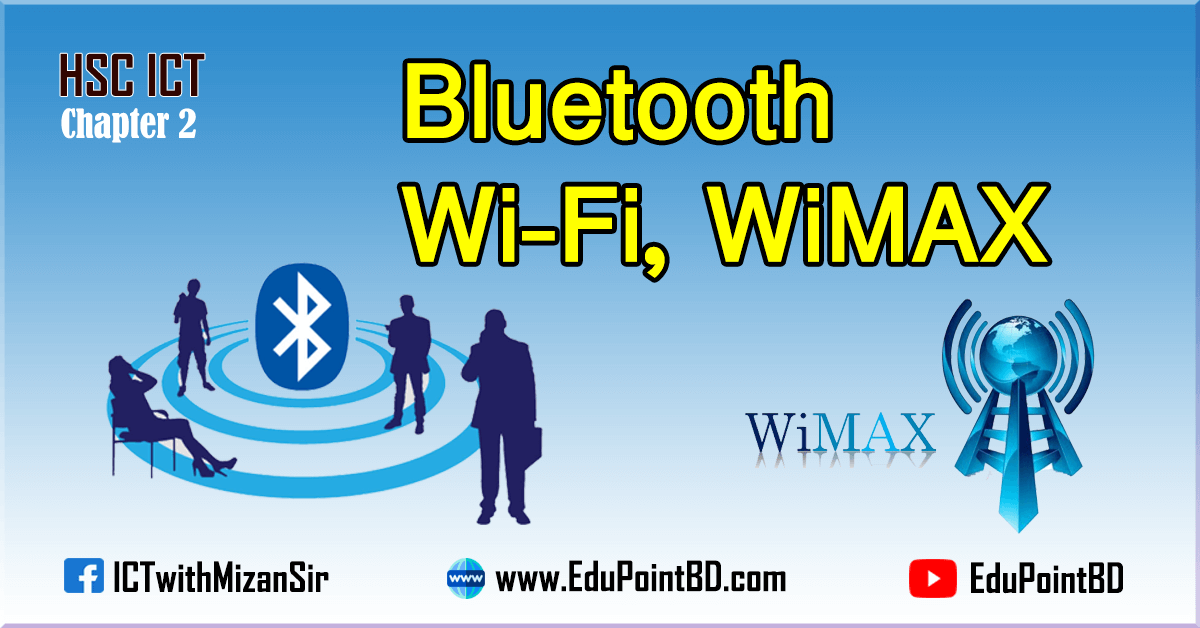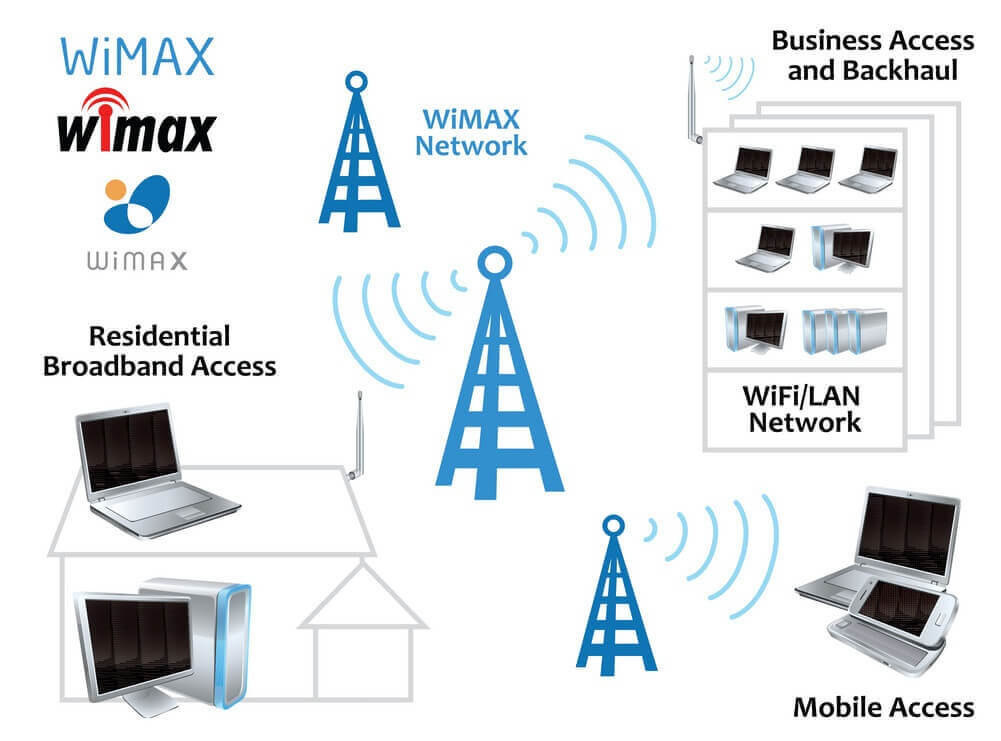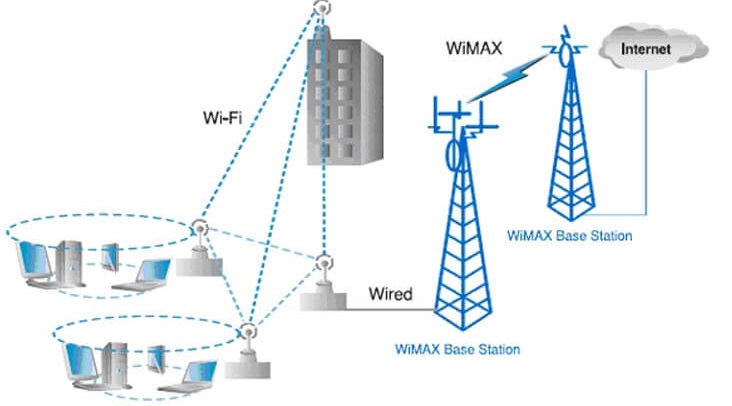
At the end of this lesson-
1. You will be able to describe wireless communication system.
2. You will be able to explain the importance of wireless communication system.
3. You will be able to explain Bluetooth technology.
4. You will be able to explain Wi-Fi technology.
5. You will be able to explain WiMAX technology.
Go for Bangla Version
What is Wireless Communication System?
Wireless Communication System where transmitting information from one point to other, without using any any physical medium.
Some of the important Wireless Communication Systems available today are:
- Television and Radio Broadcasting
- Satellite Communication
- Radar
- Mobile Telephone System (Cellular Communication)
- Global Positioning System (GPS)
- Infrared Communication
- WLAN (Wi-Fi)
- Bluetooth
- Paging
- Cordless Phones
- Radio Frequency Identification (RFID)
Wireless Communication systems can be again classified as Simplex, Half Duplex and Full Duplex.
Advantages of a Wireless Communication System:
- Mobility is the main advantage of wireless communication system. It offers the freedom to move around while still connected to network.
- Users are also able to share files and other resources with other devices that are connected to the network without having to be cabled to a port.
- Wireless networks can sometimes handle a larger amount of users because they are not limited by a specific number of connection ports.
- The setup and installation of wireless communication network’s equipment and infrastructure is very easy as we need not worry about the hassle of cables.
- The cost of installing wires, cables and other infrastructure is eliminated in wireless communication and hence lowering the overall cost of the system compared to wired communication system.
Disadvantages of a Wireless Communication System:
- Wireless Communication systems use open space as the medium for transmitting signals. As a result, there is a huge chance that radio signals from one wireless communication system or network might interfere with other signals.
The best example is Bluetooth and Wi-Fi (WLAN). Both these technologies use the 2.4GHz frequency for communication and when both of these devices are active at the same time, there is a chance of interference.
- One of the main concerns of wireless communication is Security of the data. Since the signals are transmitted in open space, it is possible that an intruder can intercept the signals and copy sensitive information.
- Continuous exposure to any type of radiation can be hazardous. Even though the levels of RF energy that can cause the damage are not accurately established, it is advised to avoid RF radiation to the maximum.
Types of access points
Two types of access points used for wireless communication system are :
1. Mobile Network
2. Hotspot
What is Hotspot?
A hotspot is a physical location where people may obtain Internet access, typically using Wi-Fi technology, via a wireless local-area network (WLAN) using a router connected to an Internet service provider.
Three popular technologies for creating hotspots-
- Bluetooth
- Wi-Fi
- WiMAX
What is Bluetooth?
Bluetooth is a wireless technology that allows you to create a Wireless Personal Area Network (WPAN). Its coverage area is usually 10 to 100 meters. Currently almost all electronic devices have Bluetooth built-in. However, Bluetooth connection can also be provided through USB port on different devices. In 1994, telecom vendor Ericsson invented Bluetooth. The technology is named after the tenth-century King Harald Bluetooth of Denmark, Bluetooth.

Features of Bluetooth :
1. Bluetooth is IEEE 802.15.1 standard technology.
2. Bluetooth uses a radio web with a frequency of 2.4 GHz (GHz) to transfer data between two devices over short distances.
3. Its data transmission rate is about 1Mbps or more.
4. Bluetooth can exchange signals with a maximum of 8 devices under one piconet. One of them works as a master device and the rest as a slave device. Scatter nets can be formed again by combining many piconets.
5. Data transmission mode half-duplex.
When more than two Bluetooth devices communicate with one another, this is called a PICONET. A Piconet can contain up to seven slaves clustered around a single master. The device that initializes establishment of the Piconet becomes the master. Each device can communicate simultaneously with up to seven other devices within a single Piconet.
![]()
Advantages of Bluetooth:
- It is wireless.
- It is cheap.
- It is easy to install.
- It is free to use if the device is installed with it.
Disadvantages of Bluetooth:
- It is a short-range communication network.
- It connects only two devices at a time.
Uses of Bluetooth:
- Bluetooth can be used to connect to a computer, mobile phone or any Bluetooth supported devices and exchange information.
- Bluetooth is used for wireless communication of input and output devices with computers, mobile phones or any Bluetooth supported device.
- Bluetooth is used in GPS receivers, medical devices, barcode scanners, and traffic control devices.
- Dedicated telehealth devices use Bluetooth for short-range transmission of health sensor data.
- Bluetooth is often used for control where infrared is used.
What is WiFi?
The term Wi-Fi is an acronym for Wireless Fidelity. Wi-Fi is a wireless technology that allows you to create a wireless local area network (WLAN). Its coverage area can be a room, a building or a distance of 32 meters in case of indoor and 95 meters in case of outdoor. Wi-Fi enabled devices such as a personal computer, video game console, smartphone or digital audio player can be connected to the Internet through a wireless network access point.

Features of WiFi:
- Wi-Fi is a technology of IEEE 802.11 standard.
- These radio signals transmitted from WiFi antennas are picked up by WiFi receivers, such as computers and cell phones that are equipped with WiFi cards.
- Data transmission mode of Wi-Fi technology is half-duplex.
Advantages of WiFi:
- Wi-Fi technology allows multiple computers to be connected to the Internet at the same time.
- The network does not require any license or authorization.
- The network can be easily expanded by adding new users.
- Wi-Fi is relatively inexpensive and very easy to use compared to local area networks.
Disadvantages of WiFi:
- Wi-Fi network boundaries are limited to certain areas.
- The efficiency and speed of the network is relatively low.
- Power consumption is higher than other standards.
- Signal jams or interruptions may be caused by other devices.
- There are risks of data and network security.
- The greater the distance, the lower the speed of the network and the quality of the signal.
- There is a risk of access points being used by unknown or authorized persons.
What is WiMAX?
The full form of WiMAX is Worldwide Interoperability for Microwave Access. WiMAX is a wireless technology that allows you to create a wireless metropolitan area network (WMAN). WiMAX technology provides high-speed broadband services, wireless access to the Internet over a wide area.

WiMAX has two main parts. One is the base station of WiMAX which consists of indoor and outdoor towers. The other is a WiMAX receiver with an antenna, which is connected to a computer or laptop. A WiMAX base station usually offers broadband internet access from 10km to 60km.

Features of WiMAX:
- WiMAX is IEEE 802.16 standard technology.
- Data transmission rate in this technology is 70Mbps.
- Microwave is used in this technology.
- Data transmission mode of WiMAX technology is full-duplex.
Advantages of WiMAX:
- Coverage area usually starts from 10 km to 60 km.
- Internet service can be provided to thousands of users through a single station.
- Frequency bands can be both licensed or unlicensed.
- Services are also available in remote areas; Even where the phone connection has not reached.
- Guarantees quality of service.
- Information and telecommunication technology services can be provided.
- WiMAX receiver with antenna, which is connected to any computer or laptop. As a result portability benefits are available.
Disadvantages of WiMAX:
- Multiple base stations are required if the distance is longer.
- Other wireless devices on the network may interfere with the signal.
- Installation and maintenance costs are high.
- Maintaining the right quality of service is difficult in many cases as many users access the same tower.
- Compared to others such as fiber optic cable, satellite etc, the data rate of WiMAX is very slow.
- Bad weather such as rain can disrupt its signal.
- Technology that uses more power to ensure adequate power supply to run the overall network.
Lesson Evaluation-
Knowledge Based Questions:
a) What is hotspot?
a) What is Bluetooth?
a) What is WiFi?
a) What is WiMAX?
Comprehension Based Questions:
b) “It is possible to transfer data over short distances at no cost” – Explain.
b) “Bluetooth technology is suitable for WPAN network”- Explain.
b) Explain the need for Wi-Fi password.
b) How to provide data security in Wi-Fi zone? Explain.
b) “Wi-Fi technology is suitable for WLAN network”- Explain.
b) Write the differences between Wi-Fi and WiMAX.
b) “WiMAX technology is suitable for WMAN network” – Explain.
b) Explain in which case it is reasonable to use WiMAX instead of Wi-Fi.
Creative Questions:
Read the following stem and answer the question:
Mohan, a member of Sabuj Bangla Club, transferred some pictures of the environmental disaster captured on the camera of his mobile phone to his laptop through a special protocol of IEEE 802.15 standard. Mohan later sent the pictures to other members of the club using SHARE it.
c) Explain the type of protocol used for transferring images from the laptop mentioned in the stem.
d) Compare WiMAX with the hotspots used to send pictures to other members of the club.
Read the following stem and answer the question:
Mr. Rahim bought a toy for his six-year-old son. He showed the flight of the aircraft using the remote. Her eldest son, on the other hand, uses the internet via cable with a laptop. Mr. Rahim uses wireless internet with the help of router on his smartphone.
c) Explain the technology of stimulus aircraft flight.
d) Analyze the strategic approach of Mr. Rahim and his eldest son in internet usage.
Multiple Choice Questions:
1. What is the IEEE standard of WiMAX?
a) 802.11 b) 802.11a c) 802.15 d) 802.16
2. WiMax is used to create what type of network?
a) PAN b) LAN c) MAN d) WAN
3. The network created with Bluetooth is called-
a) PAN b) LAN c) MAN d) WAN
4. What is a hotspot?
a) Special security measures
b) Wired internet system
c) Wireless internet system
d) Special types of software
5. The difference between Wi-Fi and WiMax is-
i. In the coverage area
ii. In transmission mode
iii. At transmission speed
Which one is correct?
a) i & ii b) i & iii c) ii & iii d) i, ii & iii
Written by,
- Mizanur Rahman (Mizan)
- Lecturer in ICT, Shaheed Bir Uttam Lt. Anwar Girls’ College , Dhaka Cantonment
- Founder & Author at www.edupointbd.com
- Software Engineer at mands IT
- Former Lecturer in ICT, Cambrian College, Dhaka
- Contact: 01724351470
